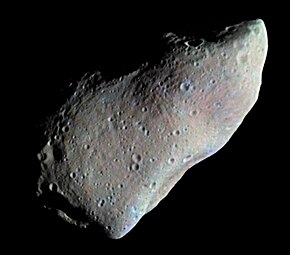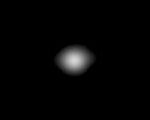
Adrastea, also known as Jupiter XV, is the second by distance, and the smallest of the four inner moons of Jupiter. It was discovered in photographs taken by Voyager 2 in 1979, making it the first natural satellite to be discovered from images taken by an interplanetary spacecraft, rather than through a telescope. It was officially named after the mythological Adrasteia, foster mother of the Greek god Zeus—the equivalent of the Roman god Jupiter.

Galileo was an American robotic space program that studied the planet Jupiter and its moons, as well as several other Solar System bodies. Named after the Italian astronomer Galileo Galilei, the Galileo spacecraft consisted of an orbiter and an atmospheric entry probe. It was delivered into Earth orbit on October 18, 1989, by Space ShuttleAtlantis on the STS-34 mission, and arrived at Jupiter on December 7, 1995, after gravity assist flybys of Venus and Earth, and became the first spacecraft to orbit Jupiter. The spacecraft then launched the first probe to directly measure its atmosphere. Despite suffering major antenna problems, Galileo achieved the first asteroid flyby, of 951 Gaspra, and discovered the first asteroid moon, Dactyl, around 243 Ida. In 1994, Galileo observed Comet Shoemaker–Levy 9's collision with Jupiter.
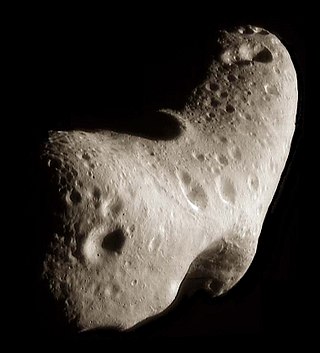
433Eros is a stony asteroid of the Amor group, and the first discovered, and second-largest near-Earth object. It has an elongated shape and a volume-equivalent diameter of approximately 16.8 kilometers. Visited by the NEAR Shoemaker space probe in 1998, it became the first asteroid ever studied from its own orbit.

Callisto, or Jupiter IV, is the second-largest moon of Jupiter, after Ganymede. In the Solar System it is the third-largest moon after Ganymede and Saturn's largest moon Titan, and nearly as large as the smallest planet Mercury. Callisto is, with a diameter of 4,821 km, roughly a third larger than Earth's Moon and orbits Jupiter on average at a distance of 1,883,000 km, which is about six times further out than the Moon orbiting Earth. It is the outermost of the four large Galilean moons of Jupiter, which were discovered in 1610 with one of the first telescopes, being visible from Earth with common binoculars.
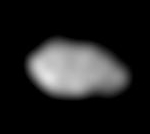
Metis, also known as Jupiter XVI, is the innermost known moon of Jupiter. It was discovered in 1979 in images taken by Voyager 1, and was named in 1983 after the Titaness Metis, the first wife of Zeus and the mother of Athena. Additional observations made between early 1996 and September 2003 by the Galileo spacecraft allowed its surface to be imaged.

Vesta is one of the largest objects in the asteroid belt, with a mean diameter of 525 kilometres (326 mi). It was discovered by the German astronomer Heinrich Wilhelm Matthias Olbers on 29 March 1807 and is named after Vesta, the virgin goddess of home and hearth from Roman mythology.
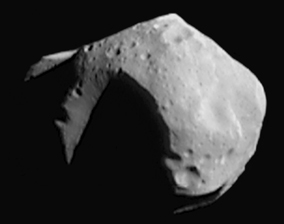
253 Mathilde is an asteroid in the intermediate asteroid belt, approximately 50 kilometers in diameter, that was discovered by Austrian astronomer Johann Palisa at Vienna Observatory on 12 November 1885. It has a relatively elliptical orbit that requires more than four years to circle the Sun. This tumbling asteroid has an unusually slow rate of rotation, requiring 17.4 days to complete a 360° revolution about its axis. It is a primitive C-type asteroid, which means the surface has a high proportion of carbon; giving it a dark surface that reflects only 4% of the light that falls on it.

Amalthea is a moon of Jupiter. It has the third-closest orbit around Jupiter among known moons and was the fifth moon of Jupiter to be discovered, so it is also known as Jupiter V. It is also the fifth-largest moon of Jupiter, after the four Galilean moons. Edward Emerson Barnard discovered the moon on 9 September 1892 and named it after Amalthea of Greek mythology. It was the last natural satellite to be discovered by direct visual observation; all later moons were discovered by photographic or digital imaging.

243 Ida is an asteroid in the Koronis family of the asteroid belt. It was discovered on 29 September 1884 by Austrian astronomer Johann Palisa at Vienna Observatory and named after a nymph from Greek mythology. Later telescopic observations categorized Ida as an S-type asteroid, the most numerous type in the inner asteroid belt. On 28 August 1993, Ida was visited by the uncrewed Galileo spacecraft while en route to Jupiter. It was the second asteroid visited by a spacecraft and the first found to have a natural satellite.

Phobos is the innermost and larger of the two natural satellites of Mars, the other being Deimos. The two moons were discovered in 1877 by American astronomer Asaph Hall. Phobos is named after the Greek god of fear and panic, who is the son of Ares (Mars) and twin brother of Deimos.
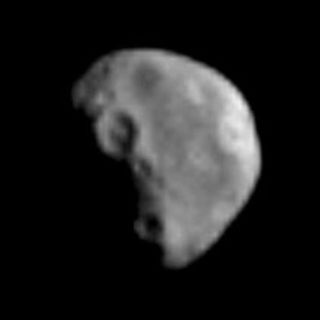
Dactyl is a tiny asteroid moon 1,200 by 1,400 by 1,600 m, in size) that orbits 243 Ida, a main-belt asteroid. It was imaged by the Galileo spacecraft on August 28, 1993; Dactyl was discovered while examining the delayed image downloads from Galileo on February 17, 1994. It was provisionally designated S/1993 (243) 1. The satellite was named after the mythical creatures called dactyls, who, according to Greek mythology, lived on Mount Ida.

Thebe, also known as Jupiter XIV, is the fourth of Jupiter's moons by distance from the planet. It was discovered by Stephen P. Synnott in images from the Voyager 1 space probe taken on March 5, 1979, while making its flyby of Jupiter. In 1983, it was officially named after the mythological nymph Thebe.

Pwyll is an impact crater on the surface of Jupiter's moon Europa. It is thought to be one of the youngest features on the moon. The crater was first observed from Voyager images in 1986, and the name was officially recognized by the IAU in 1997, after Pwyll of Welsh mythology.
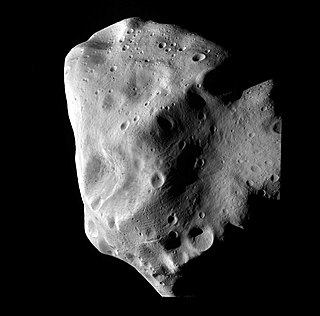
21 Lutetia is a large M-type asteroid in the main asteroid belt. It measures about 100 kilometers in diameter. It was discovered in 1852 by Hermann Goldschmidt, and is named after Lutetia, the Latin name of Paris.

32 Pomona is a stony main-belt asteroid that is 81 kilometres (50 mi) in diameter. It was discovered by German-French astronomer Hermann Mayer Salomon Goldschmidt on October 26, 1854, and is named after Pōmōna, the Roman goddess of fruit trees.
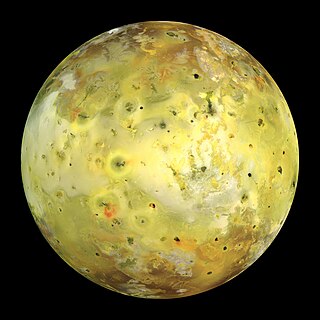
Io, or Jupiter I, is the innermost and second-smallest of the four Galilean moons of the planet Jupiter. Slightly larger than Earth's moon, Io is the fourth-largest moon in the Solar System, has the highest density of any moon, the strongest surface gravity of any moon, and the lowest amount of water by atomic ratio of any known astronomical object in the Solar System. It was discovered in 1610 by Galileo Galilei and was named after the mythological character Io, a priestess of Hera who became one of Zeus's lovers.

The Flora family is a prominent family of stony asteroids located in the inner region of the asteroid belt. It is one of the largest families with more than 13,000 known members, or approximately 3.5% of all main-belt asteroids.
Damon Paul Simonelli was a planetary scientist who worked for Cornell University and the National Aeronautics and Space Administration (NASA) in the U.S. He was a pioneer in the development of radiative transfer models to analyze astronomical objects.

Pola Regio is a geological structure on the asteroid 243 Ida. It was named after Pula (Pola), the place where Austrian astronomer Johann Palisa discovered Ida on 29 September 1884; this name was officially approved by the International Astronomical Union (IAU) in 1997. It is located on Ida's 180° E end, antipodal to Vienna Regio.

Zethus is a large crater on Jupiter's moon Thebe. The crater is named after Zethus, the husband of the nymph Thebe in Greek mythology, and is the only named surface feature on Thebe. It measures 40 km (25 mi) across in diameter, making quite large when compared to Thebe itself. Zethus, like many other craters on Thebe and Amalthea has bright spots located near its rim. Zethus never faces Jupiter due to being tidally locked to Jupiter in a way that Thebe's long axis points towards Jupiter.
